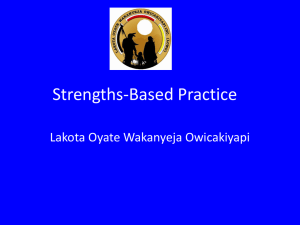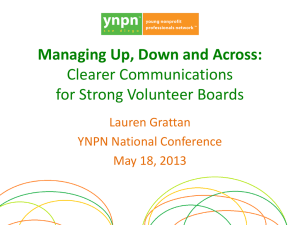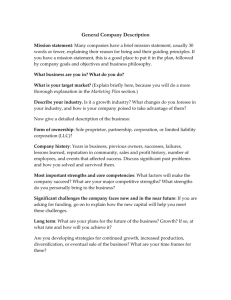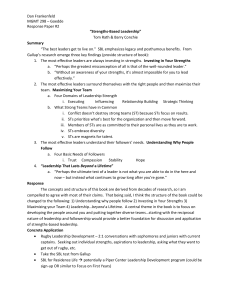Open web link
advertisement
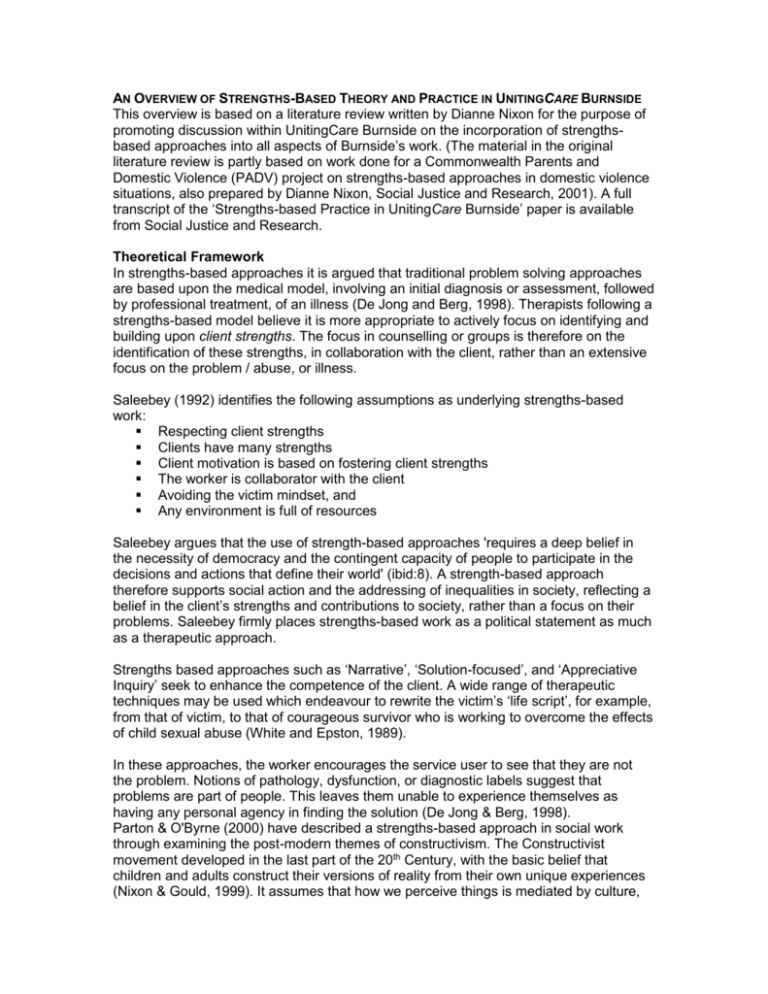
AN OVERVIEW OF STRENGTHS-BASED THEORY AND PRACTICE IN UNITINGCARE BURNSIDE This overview is based on a literature review written by Dianne Nixon for the purpose of promoting discussion within UnitingCare Burnside on the incorporation of strengthsbased approaches into all aspects of Burnside’s work. (The material in the original literature review is partly based on work done for a Commonwealth Parents and Domestic Violence (PADV) project on strengths-based approaches in domestic violence situations, also prepared by Dianne Nixon, Social Justice and Research, 2001). A full transcript of the ‘Strengths-based Practice in UnitingCare Burnside’ paper is available from Social Justice and Research. Theoretical Framework In strengths-based approaches it is argued that traditional problem solving approaches are based upon the medical model, involving an initial diagnosis or assessment, followed by professional treatment, of an illness (De Jong and Berg, 1998). Therapists following a strengths-based model believe it is more appropriate to actively focus on identifying and building upon client strengths. The focus in counselling or groups is therefore on the identification of these strengths, in collaboration with the client, rather than an extensive focus on the problem / abuse, or illness. Saleebey (1992) identifies the following assumptions as underlying strengths-based work: Respecting client strengths Clients have many strengths Client motivation is based on fostering client strengths The worker is collaborator with the client Avoiding the victim mindset, and Any environment is full of resources Saleebey argues that the use of strength-based approaches 'requires a deep belief in the necessity of democracy and the contingent capacity of people to participate in the decisions and actions that define their world' (ibid:8). A strength-based approach therefore supports social action and the addressing of inequalities in society, reflecting a belief in the client’s strengths and contributions to society, rather than a focus on their problems. Saleebey firmly places strengths-based work as a political statement as much as a therapeutic approach. Strengths based approaches such as ‘Narrative’, ‘Solution-focused’, and ‘Appreciative Inquiry’ seek to enhance the competence of the client. A wide range of therapeutic techniques may be used which endeavour to rewrite the victim’s ‘life script’, for example, from that of victim, to that of courageous survivor who is working to overcome the effects of child sexual abuse (White and Epston, 1989). In these approaches, the worker encourages the service user to see that they are not the problem. Notions of pathology, dysfunction, or diagnostic labels suggest that problems are part of people. This leaves them unable to experience themselves as having any personal agency in finding the solution (De Jong & Berg, 1998). Parton & O'Byrne (2000) have described a strengths-based approach in social work through examining the post-modern themes of constructivism. The Constructivist movement developed in the last part of the 20th Century, with the basic belief that children and adults construct their versions of reality from their own unique experiences (Nixon & Gould, 1999). It assumes that how we perceive things is mediated by culture, language, and subjective meaning, and that human experience reflects a dynamic interplay between events and the meanings we attach to them. We constantly shape our reality and negotiate its meaning as a social process. What is 'real' is what we believe to be so and what others may choose to agree with (Gergen, in Saleebey 1981:21). It is opposed to the scientific model of knowledge, whereby reality can be measured, tested, and objectively verified. Problems therefore reflect not what we are looking at, but who is doing the looking. Parton & Byrne (200:24) summarize the underlying assumptions of this approach as: practitioners must develop a critical stance towards assumed ways of understanding the world, including their own assumptions Categories and concepts commonly used to understand the world are seen as culturally and historically specific, and therefore meaning varies over time and place. Practitioners should not assume that their ways of understanding are necessarily the same as others' and are any nearer the truth; Knowledge of the world is developed between people in their daily interactions such that practitioners should be centrally concerned with the social processes carrying these changes, and how the knowledge can be changed, and The social world is the product of social processes. There cannot be any given, determined nature of the world 'out there' and no hidden essences inside people that make them what they are. No-one is intrinsically ‘evil’ and no situation lacks strengths. Different methodologies that use a strengths-based approach Any way of working with others can use a strengths-based approach, however there are a few approaches, outlined below, which have been specifically developed on a strengths-based philosophy, and are commonly associated with this approach. Nevertheless using a strengths-based approach should not be seen as limited to these therapeutic and group approaches. Solution-Focused Brief Therapy ‘Solution Focused Brief’ therapy has a central philosophy that clients bring with them strengths and capacities they can access and develop to make their lives more satisfactory (Corcoran 2000:468). The client is the expert and the therapist is responsible for developing a collaborative context and helping the client articulate desired changes. The working principles of Solution Focused intervention include the following: People are in a constant process of making sense of their experience. Beliefs about self and others, values, expectations, societal prescriptions serve to keep people from noticing information about themselves, others or relationships that would allow them to move forward. People experience problems as problems and generally want things to be better, and the persistence of difficulties does not imply addiction. It is unhelpful to think in terms of resistance or denial. People’s potential for change is limited by their awareness of other possibilities, and this awareness needs to be developed by the worker. Problems do not indicate pathology. Problems are seen as occurring within the context of human interaction. Problem patterns include both behaviour and perceptions. People have tried to solve their problems, but the attempts have failed to bring about the desired relief. These attempted solutions frequently lead people to focus more on the problem, and how they feel stuck, than to focus on alternate solutions. People have within them a wealth of resources both known and unknown to them. One of the main effects of problems, and peoples’ experience of them is to blind them from noticing their strengths and capabilities, or the solutionorientated behaviour that already exists. The problem is the problem. The person is not the problem. Notions of pathology, dysfunction and diagnostic labels suggest that problems are part of people, which leaves them unable to experience themselves as having any personal agency in finding the solution. Change is constant and, in fact, inevitable. Snowball effect...small change can lead to bigger and bigger change. The best changes are those identified by the client rather than the therapist, and they can be framed as part of a process of small steps. Every problem-dominated pattern includes examples of exceptions that serve as hints towards solutions. New and beneficial meanings can be constructed for at least some aspects of the client's complaint. The problem can be redefined in a way that promotes the identification of existing solution-behaviour. “If it works, don’t fix it”. In fact, encourage the client to do more of it. If it’s not working do something else. Effective therapy can be done even when the therapist cannot describe exactly what the problem is, or when clients don’t agree on the definition of the problem. It is more important to know what will be different when the problem is solved. Solution focused approaches emphasize the importance of ‘well formed goals’, the characteristics of which include: Stated in positive terms In a process form In the here and now As specific as possible Within the client’s control In plain language (De Jong, P. & Berg, I.S., 1998) Narrative Therapy Narrative therapy believes that problems arise because people are induced by our culture into subscribing to narrow and self-defeating views of themselves and the world. Narrative therapies complete the process of widening the circle of culpability for problems (Schwarz, 1999:263). White and Epson 1990 (in Etchison 2000:61) state that narrative therapy is based on the idea that problems are manufactured in social, cultural and political contexts. Thus change occurs by exploring how language is used to construct and maintain problems (Cowley & Springen, 1995, in Etchison, 2000:61). Experiences are collapsed into narrative structures or stories to give a frame of reference for understanding and making experiences understandable. Omer (1993,1994, in Parton & O'Byrne, 2000:161) identified 4 elements in narrative therapy that are particularly valuable, though not of universal effectiveness. They are: Use of client's narratives Validating the seriousness of problems Externalizing the problem to make the client a hero/heroine Developing options for a new character. The worker and the client therefore re-construct the client's story together. As Parton & O'Byrne state (2000:162) 'No two solutions will ever be the same and we cannot tell what any particular solution will look like until it is built, though they may be built in a similar manner.' The basic assumption of narrative therapy is that service users have the resources that are needed and also know how to get what they want, but it is only by talking about it do they get to know what they know (Parton & O'Byrne 2000:162). Appreciative Inquiry Appreciative Inquiry is an approach that extends strengths-based concepts into organizational group learning. The approach can be used to plan for and create change by looking for what works within a group, and build on these to create new ways of working together. The approach is built on the following principles: Inquiry into what is possible should begin with appreciation. The primary task is to describe and explain those exceptional moments, which give energy to the group and activate member's competencies and energies. Inquiry into what's possible should be applicable. Study should lead to the creation of knowledge that can be used, applied, and validated in action. Inquiry into what is possible should be provocative. A group is capable of becoming more than it is at any given moment, and learning how to determine its own future. Inquiry into the human potential in the group should be collaborative. This assumes an inseparable relationship between the process of inquiry and its content. Hammond (1996) argues strongly that in order to adopt a strength-based approach in groups, the 'language of deficit' must be actively replaced, in order to address unconscious sets of assumptions that create individual frames of reference. In order to apply ‘Appreciative Inquiry’ to organisational group learning, Hammond suggested the following process: clearly identify the topic generate the questions from within the group explore and gather existing information from within the group present and combine this information to create new a new information base for future action. Evaluating Strengths-Based Approaches Evaluations and studies of outcomes of strengths-based approaches in therapeutic settings are limited in their validity by their general lack of control groups, which means there is no real comparison point to measure results from. In general, evaluations suggest that this way of working is at least as effective as others, even though it tends to have shorter involvement in people's lives (Parton & O'Byrne, 2000). The authors cite ongoing research by de Shazer's team (ibid:153) to argue that the studies suggest that not only is the effect maintained over time, but it actually tends to increase its impact rather than wash out. Sundman’s research in ‘Solution Focussed Brief’ therapy in Finland showed that there were no significant changes in goal achievement, but in line with solution focused orientation there were increases in positive statements, goal focusing, and shared views between therapists and their clients. (Sundman 1997:159). Clients and therapists ‘felt better’ even though the problem remained the same as the control group, but solutions focused clients were more focused towards their goals and more engaged in problem solving with the therapist. The process, but not necessarily the outcomes, was successful. McKeel (1996, in Miller, Hubble & Duncan) in an overview of evaluations and research on Solution Focussed Brief therapy argues that evidence is building that this approach can be effective for a wide range of clinical presentations, including severe and chronic problems. However, the author admits that knowledge on which interventions and approaches, currently used under the umbrella of Solution Focussed Brief therapy, are most effective is poorly researched. McKeel urges practitioners to use a research and development strategy when exploring new or untested interventions. The author outlines this strategy as similar to a small research study, where new approaches are tested over a number of interventions and then evaluated and assessed using standard questions which include client input. The following general points can be made from existing research and evaluations of strengths-based therapeutic programs, mainly solution-focused brief therapy: At a one-year follow-up, 64% of clients were shown to have improved in their problem-solving approaches. However those with longstanding problems do less well. Equal outcomes found for all social classes (Macdonald, 1997) For solution-focused parenting groups, improvement was shown on the Parenting Skills Inventory, no change on Family Strengths assessment (Zimmerman et al, 1996) Research suggests that brief therapy is an effective treatment for a broad range of client problems such as depression, suicide, sleep problems, eating disorders, parent-child conflict, marital/ relationship/ sexual problems, sexual abuse, family violence and self-esteem problems (de Jong & Berg, 1998). The number of sessions a client attends and whether they accomplish their treatment goals seem related. The highest success rate is where clients attend four or more sessions, the lowest when they attend below three sessions (Macdonald, 1997) In their evaluations of brief therapy counselling, clients nominate their relationship with their therapist as more influential to treatment success than any specific technique their therapist uses (Shilts, Rambo & Hernandez, 1997; Metcalf et al, 1996). Qualities included respectfulness, time to listen, and the care and concern the therapist showed In one study (Sunderman 1997, in Parton & O'Byrne p.155) of a social work team in Helinski using solution-focused work, a comparison group was used. While no significant differences were found with the comparison group in terms of goal achievement, the service users were more satisfied, more goal focused and more engaged with workers in joint problem-solving i.e. the work was more collaborative. Besa (1994, in Parton & O'Bryne p.157) evaluated narrative-based family work with 6 families. In 5 of the families the approach was found to produce reductions in parentchild conflict of 88-98%. The report states that the approach was 'based on the notion that healthy exceptions can be found within a problem-saturated story.' In summary: Research into strengths-based therapies is generally unclear due to poor methodology and lack of comparison groups, however, Outcomes appear to be as good as traditional forms of therapies, and there are some indicators that the effects strengthen with time Strength-based approaches can be demonstrated to be more collaborative in addressing issues, thus more respectful of the client's abilities and strengths The 'fit of the therapist with the approach is important to positive outcomes Clients indicate that, for them, relationship with the therapist is an important key, whatever the approach used. Working with disadvantaged and chaotic families in a strengths-based model In a study of parenting stress, socio-economic disadvantage and attendance at counselling, Andra and Thomas (1995) found that less attendance to group therapy for children was significantly associated with a greater degree of parenting stress, while less attendance at counselling for parents was significantly associated with greater socioeconomic disadvantage. High levels of parenting stress and socio economic disadvantage should signal to practitioners that child and parents may exhibit low attendance rates. Interventions which decrease the parent’s depression, increase their parenting competence, and support the development of attachment so that the child can reinforce the parent, may also increase therapy attendance and subsequently improve chances for a successful therapy outcome. In her overview of theoretical orientations of family programs, Corcoran (2000) found that although there was insufficient evidence for any one approach, behavioural and cognitive-behavioural approaches show promise in effecting family change in chaotic or abusive families. Working with children and young people in a strengths-based model. 'They come in and out of your life, but they can go home at the end of the day - you've got to deal with things all of the time' (boy 14 years, Butler & Williamson, 1994) In her critique of child welfare policy in NSW, Wilkinson (1999:137) argues that child welfare decisions are not decisions about the welfare of children, but are 'decisions about the adequacy of parenting, about the conduct of the child, about the child's environment and about intra-family relationships.' Wilkinson states that unless the stories of the children are incorporated into the discussion of their needs, the discussion supports children as a 'virtual reality' in social welfare work. Through the workers' engagement of children in a strengths-based model, with the aim of putting aside suppositions and professional knowledge as to what they think the children 'need', children may begin to be heard within social welfare work. Frey (1998:233) in his paper on children's rights in domestic violence identifies developmental psychology as one potential barrier to hearing children. He argues that each developmental stage becomes a rung in the climb towards adulthood, with adulthood being taken as the viewpoint for the entire life. Frey argues for treating whatever part of their lives they are in as inherently valuable instead of some greater scheme of development. Garbarino et al (1992) states in his preface to What Children Can Tell Us, that 'child development knowledge (especially when combined with experience) can greatly facilitate success in adult-child communications. What it cannot do is specify the exact form that communication will take. The child, the adult, the child's relationship to the adult, the child's previous experience in communicating (or not communicating) with adults, the specific meaning attributed to the setting in which the adult-child encounter takes place - all these factors influence outcomes. Therefore, each has a bearing on what technique to use, which approach to adopt.' Butler & Williamson (1994) discuss strategies to support the child in defining the issues for themselves e.g. identifying the worst experiences in their lives, rather than defining the referral problem for them, encouraging them to describe situations likely to make them anxious or concerned when they thought about the future. In their documentation of this style of intervention, the authors found that it was not always the referral problem which in fact caused the 'worst experience' but the sequel of events associated with it. Most children and young people in the Butler & Williamson study related feelings of distrust to interactions with adults, particularly professionals, assigned to their 'cases'. Over 25% of the children and young people held strong beliefs that they would talk to no-one about their issues, while many others said that they would only reluctantly discuss their personal circumstances with others. Frey (1998) argues that children are often not used to being heard, and where their voice is sought it is often in the context of adult processes which they do not understand and which are often alienating. Therefore, where their views are sought there is a tendency towards tokenism rather than true participation. Power within adult-child relationships is rarely truly shared. Children and young people in the Butler & Williamson study clearly demonstrated their understanding of the different perceptions, priorities and world views of adults, and how these inhibit the adult's abilities to meet the child's needs. Tendencies by adults to trivialize, under-react or over-react, or just react inappropriately were the main issues for children and young people. 'The dilemma for children and young people, as they see it, is that once they convey something to adults, the power to determine what should then be done is too often - taken out of their hands' (1994:82). In summary: In order to work within a strengths-based model, practitioners must examine the preconceptions they hold about children, and those of the wider society Child development knowledge is useful, but should not define the child's responses for the worker Children and young people are unlikely to talk to adults about their problems, particularly caseworkers they don't trust Reflections on Strengths-based practice from Burnside Workers Annette Osbourne (Administration, Macarthur): Whilst I have been very aware of this way of working, through lack of understanding and confidence in my skills I had not applied this to my way of working - that was up until recently. I attended an in-house training course facilitated by Anne Heath and Anthea Jackson around Strength Based Work and our Service Folders. Through this training I began to think about the way that supervision happens for the administration team, and how problem-saturated that can become. I had some ideas. However, before making any changes I wanted to get a feel of how staff who I supervised felt. Then I took a risk. I met with them all individually and proposed my idea: New name for supervision Notes from meeting with be in the form of a letter (strengths based) Folder made up for each employee noting: - achievements - goals - work plan - notes on decorative paper - future dates We also agreed that there did not have to be a particular issue for discussion it could be a time when we just reflected on the past few weeks, and maybe something in that conversation would surface. And the opportunity then happens !!!! This folder would be a tool that would be used in the annual appraisal. For example we tend to forget all the achievements that have happened through the year and can only focus on the more recent ones. The work plan is the same as our appraisal however its a common occurrence that plans change throughout the year and in using this folder we would be better able to track why those changes came about. Goals, too, could change and that would be another good topic of conversation and to reflect the reasons for change. The discussions that took place were very successful and all staff members where enthused by the suggestion. We have now changed the name of supervision to 'Time Out', I have started with the letter writing. The response has been very positive. Its very early days and I'm sure that we might make minor changes but I'm feeling very confident as to how it seems to be panning out. Andrew King (Groupwork, Western Sydney): For me strengths based work has three major ingredients: Specific feedback - Your professional practice is more strengths based when workers are more confident about expressing their observations to relevant service users. Many people hold back a tremendous amount of things that they notice about others. While this is often good regarding negative criticisms, it reduces the amount of positive comments that we give other people. Strengths based work takes the risk of expressing these observations. Focus on what is emerging rather than using static descriptions - As observations are made of how people manage situations in their life, feedback is given. A strengthsbased practitioner focuses on what is emerging rather than describing the problematic or negative issues alone. The strength that keeps people trying another time when faced with a difficult circumstance has been identified in research as a major force of change. Choices/ Decision-Making - A key part of change is empowerment. Allowing people to make decisions in their life and experiencing the consequences of those decisions. Often, due to a lack of reflection, many people don’t realise the choices that are possible. Doug Cantril (Father’s Group, Port Macquarie): The strengths-based procedure that I have employed quite effectively is to encourage service users to explore the strengths they offer others (through an exercise with the St Luke’s ‘Strength in Teams’ Cards) in the group environment. The effect of this flows on in learning to find encouraging words to offer significant people in their lives. Often, it seems that service users come to group uncomfortable with the idea that they may have something to offer other members. This exercise allows all members to participate at a level that is comfortable for them and other group members. Chris Sinclair (NEWPIN): When we talk with the women we take away the ‘problem pathology’ and put the issue in a social context. We help them to see the issue as a social construct, and that together we can ‘unconstruct’ it. Nothing is permanent and all can be changed – in fact, change is desirable and risk can be good! If the women can have a vision for the future, then they can take control, and there is movement. It’s good to celebrate survival, then ask ‘where to now’? References Andra, M. & Thomas, A. (1998) “The influence of parenting stress and socio-economic disadvantage on therapy attendance among patients and their behaviour disordered preschool children” in Education & treatment of children, Pressley Ridge Schools, Pittsburg. Butler, I. & Williamson, H. (1994) Children Speak: Children, trauma and social work. Longman: UK. Corcoran, J. & Stephenson, M. (2000) “The Effectiveness of Solution Focused Therapy with Child Behaviour Problems: A Preliminary Report” Families in Society 2000: 468 – 474 Corcoran, J. (2000) Evidence-Based Social Work Practice with Families: A Lifespan Approach. Springer Publishing Co., NY. De Jong, P. & Berg, I.S., (1998), Interviewing for Solutions, Brooks/Cole: USA. Etchison, Mary (2000) Review of narrative therapy: Research and utility Journal of Family Studies; Jan. 2000: 61-66 Erikson, E. (1975) Life History and the Historical Moment. Norton: New York Frey, R. (1998) Children's rights: What does it really mean? Paper presented at the 2nd National Conference on Children, Young People & Domestic Violence 'Everybody's Business' Brisbane, Sept-Oct 1998. Garbarino, J., Stott, F., & the Faculty of the Erikson Institute (1992) What children can tell us: Eliciting, interpreting, and evaluating critical information from children. JosseyBass, California Hammond, S. (1996) The thin book of appreciative inquiry (2nd edn) Thin book publishing co. USA. Hawkins, A.J. & Dollahite, D.C. (1997).. Generative Fathering: Beyond Deficit Perspectives. Sage: Thousand Oaks King, A. (2000) Working with fathers: The non-deficit perspective. Children Australia, Vol 25, No.3. Miller, S., Hubble, M. & Duncan, B. (eds, 1996) Handbook of solution-focused brief therapy. Jossey-Bass Inc., Calif. Nixon, D. & Gould, K. (2nd edn., 1999) Emerging: Child Development in the first three years. Social Science Press, Australia Parton, N. & O'Byrne, P. (2000) Constructive Social Work: towards a new practice. MacMillan Press:UK Saleebey, D. (Editor, 1992) The Strengths Perspective in Social Work Practice. Longman: NY & London Schwartz, R. (1999) “Narrative therapy expands and contracts family therapy’s horizons” Journal of Marital and Family Therapy; April 1999 pp263-266 Shilts, L. Rambo, A. & Hernandez, L. (1997) “Clients helping therapists find solutions to their therapy” Contemporary Family Therapy, 19: 117-132. Sundman, Peter (1997) ‘Solution focused ideas in social work’ Association For Family Therapy and Systemic Practice’ 159 Wilkinson, M. (1999) Virtual Reality: Children as constituents in social welfare and social policy constructions. Paper presented at conference Taking Children Seriously (UWS, Sydney, Childhood & Youth Policy Research Unit). Zimmerman, T. Jacobson, R. MacIntyre, M. & Watson, C. (1996) Solution-focused parenting groups: An empirical study. Journal of systemic therapies 15: 12-25


